As an Amazon Associate, we earn from qualifying purchases with no additional costs for you.
Whetstones are one of the best means to keep your knives sharp and in good condition. Whetstones require maintenance to ensure that the surface continues to sharpen your knives correctly and accurately. One of the important maintenance tasks is flattening the sharpening stones. What is the best way to flatten your whetstones to keep them working well?
The four proven methods to effectively flatten sharpening stones or whetstones are as follows.
- Sandpaper with a hard, flat backing.
- Using three other whetstones to flatten the uneven stone
- A lapping stone designed to flatten whetstones
- Use a coarse diamond plate to grind the stone flat.
Several methods can be used to flatten whetstones, and the different methods work with varying levels of success, depending on the types of sharpening stones you own. The hardness and coarseness level of the grit of the stone will determine the best method for flattening. We have detailed the best-proven methods for flattening your whetstones.
If you are interested in checking out the best whetstones for your knives, we recommend and use you can find them by clicking here (Amazon link).

Why Do You Need to Flatten Your Sharpening Stones?
A whetstone is essentially a block of abrasive material that has sufficient coarseness and durability to wear away steel.
This process allows us to run a knife edge along the surface of the whetstone and remove steel in a controlled fashion to produce a sharp, refined edge.
The abrasive action of passing the steel of the blade across the whetstone grinds particles off the steel and produces wear and tear on the whetstone’s surface.
The wear on the whetstone will eventually create an uneven surface on the sharpening face of the stone. The longer the stone is used, the more uneven the sharpening surface will become.
At some point, the unevenness of the surface will affect the sharpening process. A non-flat surface will make it difficult to maintain the sharpening angle on the blade’s edge. This will make it difficult to get the knife sharp at all since the constantly changing angle will transfer imperfections to the edge.
What Type Of Wear Occurs On A Whetstone
Beginners to knife sharpening will find that they need to flatten their whetstones more frequently than more experienced people. The cause of this is a lack of finesse in the sharpening technique. As your sharpening technique improves, you will produce more even wear across the whetstone’s surface.
You will also be more aware of the potential for uneven wear of the stone and take the necessary steps to reduce this issue on the sharpening surface.
The whetstone will experience greater wear in areas where you apply more pressure as the person performing the sharpening process. Uneven pressure across the length of the blade as it is passed across the stone may cause different wear in spots or on either side of the whetstone.
The most common wear pattern on a whetstone, which occurs irrespective of the quality of your technique, is dishing. This dishing pattern is where the whetstone’s central region takes on a curved profile, and the near and far edges are at a higher level than the central part of the stone.
The pattern occurs due to less pressure at the beginning of a sharpening stroke, more pressure in the middle of the stroke, and less pressure again at the end of the stroke as you pull the knife off the stone.
TIP: Do knife sharpeners wear out, and how do you know when they need replacing? Find out the complete answer in the article below:
Do Knife Sharpeners Wear Out? Answer for Various Sharpeners
Do Whetstones Need To Be Flattened?
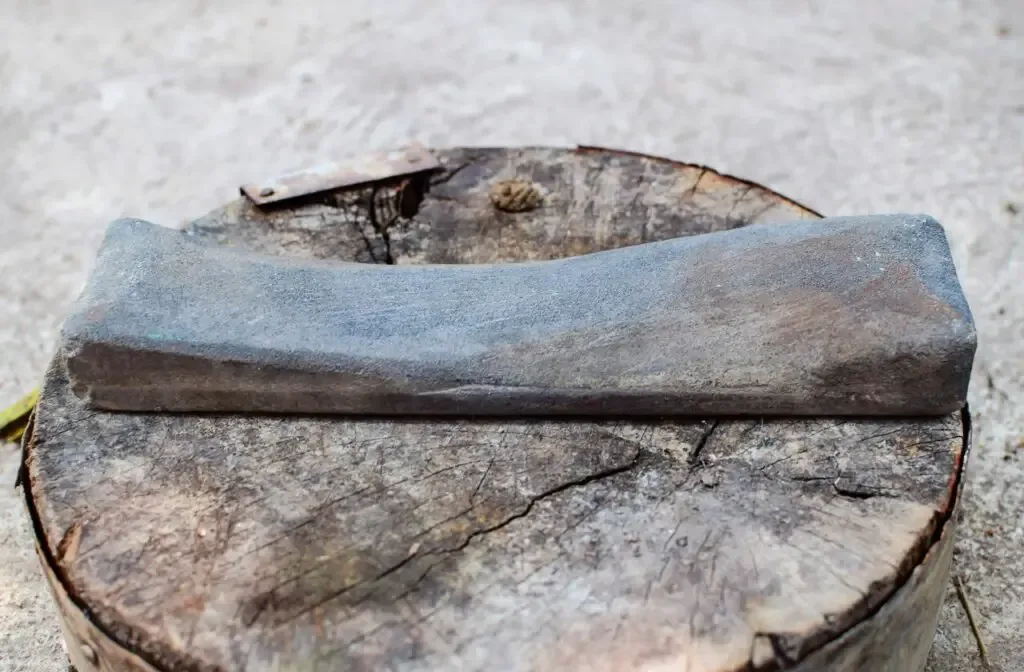
As we have already discussed, whetstones are susceptible to wear during the process of sharpening knives and other tools.
If the uneven wear on the stone is not addressed, the wear on the whetstone will get to the point where it is no longer effective in putting a sharp edge on your knives.
The only way to restore the effectiveness and accuracy of the whetstone is to flatten the surface, eliminating the uneven wear causing the problem.
Flattening a whetstone evens out the surface and removes debris such as steel particles from the whetstone’s surface. This cleaning effect contributes to restoring and improving the abrasive quality of the whetstone.
Consequently, flattening a whetstone is important for maintaining your sharpening stones and keeping them effective for their intended purpose. Regular flattening will also give you a longer use out of your whetstones, reducing the frequency with which they need to be replaced.
TIP: Are you looking to buy a new whetstone? Check out our recommendations (we personally use the first three ones):
Our PRO choice whetstones combo (Amazon links):
- Fixing stone: Whetstone SHAPTON Ceramic KUROMAKU #320
- Sharpening stone: Suehiro CERAX soaking whetstone: Medium #1000
- Finishing stone: Whetstone SHAPTON Ceramic KUROMAKU #5000
Our budget choice (Amazon link): Sharp Pebble Extra Large Sharpening Stone Set
Do Ceramic Sharpening Stones Need to be Flattened?
A frequently raised question is whether the flattening process is required on all types of sharpening stones. Ceramic stones are a stone type where flattening is repeatedly questioned since the abrasive is different from that of traditional or natural sharpening stones.
Ceramic whetstones are made from an extremely hard substance called zirconium dioxide. The only substance harder than this material is diamond.
The hardness of these stones may lead some people to think that ceramic stones do not need to be flattened. This concept is inaccurate, and ceramic stones do require flattening.
It is recommended that ceramic whetstones be flattened every time you use them to prevent uneven wear from becoming too pronounced on the stone. The hardness of the material will make it a time-consuming and difficult task to rectify severe wear on the sharpening surface.
If the flattening is performed before every sharpening session, it can take as little as 15 seconds to restore the stone. In contrast, an entire session of 15 to 30 minutes or more may be needed to restore a worn whetstone’s surface.
TIP: One of the most frequently asked beginner questions is, do sharpening stones need to be wet, or can they be used dry? Find out the answer in the article below:
Do Sharpening Stones Need To Be Wet? Complete Breakdown
How To Flatten Sharpening Stone (Whetstone)?
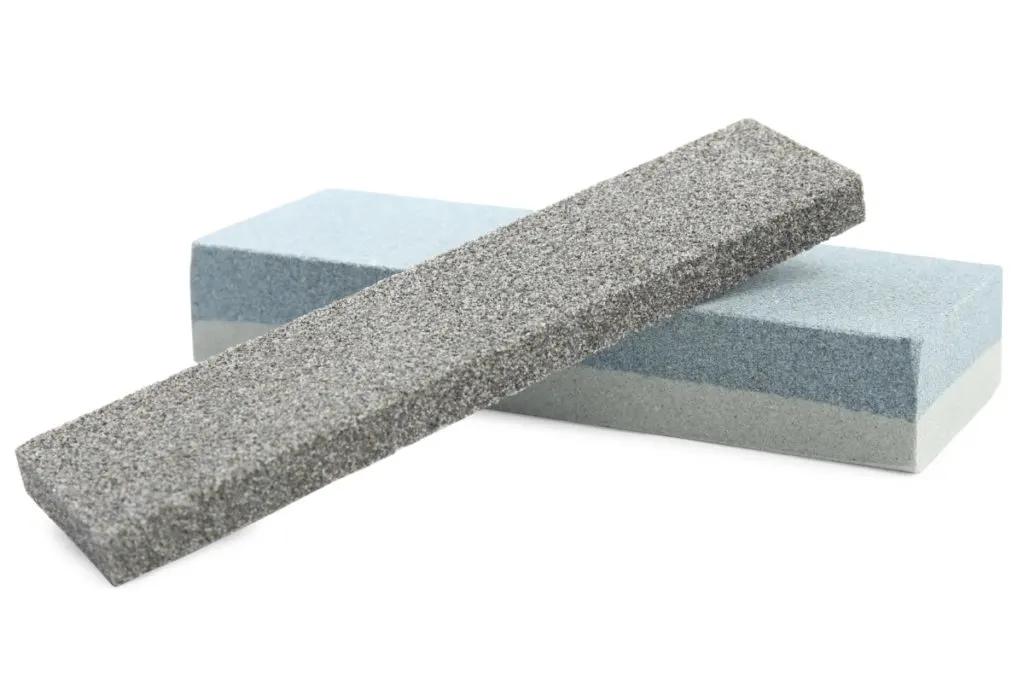
The means and the method to flatten a sharpening stone will vary according to the type of stone. Waterstones and oil stones can generally be flattened using similar sharpening tools and methods.
Diamond plates are the only whetstones that do not require flattening. These stones are constructed from a metal base with diamond fragments embedded in the surface of the plate. During the sharpening process on a diamond stone, the plate is not worn away and, therefore, does not change shape or become deformed from the process.
The only maintenance required for a diamond whetstone is to remove the particles of steel waste material from the stone’s surface. These steel particles removed from the knife’s cutting edge can clog the stone and reduce its cutting ability. Usually, a rinse with water and a light scrub with a brush is sufficient to clean the stone and restore its abrasive qualities.
Several methods can be used to flatten whetstones, including the following.
- Sandpaper on a flat surface
- Another whetstone
- A lapping stone
- A diamond plate
Each of these flattening methods has its advantages and disadvantages and different levels of effectiveness in flattening the stone. These factors influence the time it takes to flatten the whetstones and the costs involved for each method.
1. How To Flatten A Whetstone Using Sandpaper
One of the most cost-effective and simplest options to flatten a whetstone is to use sandpaper combined with a hard, flat surface.
The best sandpaper to use for this purpose is silicon carbide wet and dry sandpaper. The silicon carbide abrasive remains sharp for longer, allowing for more use from a single sheet of paper, and it abrades the whetstone’s surface very well.
The best grit to use that will provide sufficient abrasion for fast work and still leave a smooth finish on the sharpening surface is 220-grit sandpaper. A coarser grit can be used to remove material from the stone faster, but it will leave scratches on the surface, which you will need to remove with a higher grit paper.
The 220-grit offers the best grit level combination to promote fast flattening without leaving significant scratch marks on the stone.
Wet and dry sandpaper is preferred because you can use water as a lubricant on the paper, which will aid in the cutting ability of the abrasive and keep the sandpaper cleaner for longer during flattening.
A solid, flat backing is needed for the sandpaper to ensure even wear across the whetstone’s surface. A piece of plate glass, a ceramic tile, a granite cutting board, or other similar smooth, flat surface makes for an ideal backing for the sandpaper.
Tape the sandpaper to the rigid backing, squirt water onto the sandpaper using a spray bottle, and begin rubbing the stone over the surface of the sandpaper. Simply continue with this method until the whetstone surface is flat and smooth.
TIP: Sandpaper is often manufactured with similar abrasives to that of some whetstones, which suggests that sandpaper can be used as a whetstone. Check out the comparison of using whetstone and sandpaper for sharpening in the article below:
Whetstone Vs. Sandpaper: 5 Main Differences & Usage
2. Using Another Whetstone To Flatten a Whetstone
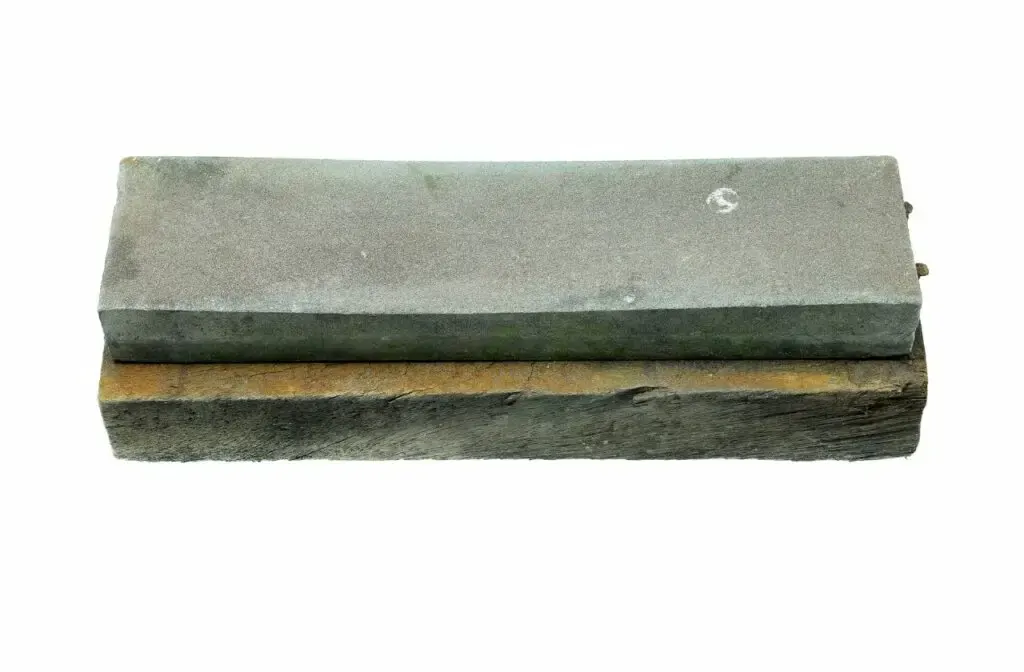
Another method to flatten a whetstone is to use other whetstones to abrade the surface of the uneven stone.
This process cannot be done with one stone; otherwise, the flat stone will take on the shape of the uneven stone, and you will have two uneven stones at the end of the process.
A minimum of 3 additional whetstones are recommended to be used alternately every few strokes during the flattening process. This method prevents one stone from taking on the shape of another and promotes even wear across all the stones.
The disadvantage of using other whetstones is that you will be adding wear to these whetstones, which you may particularly want to avoid if you use quality, expensive stones.
3. Flattening A Whetstone With A Lapping Stone
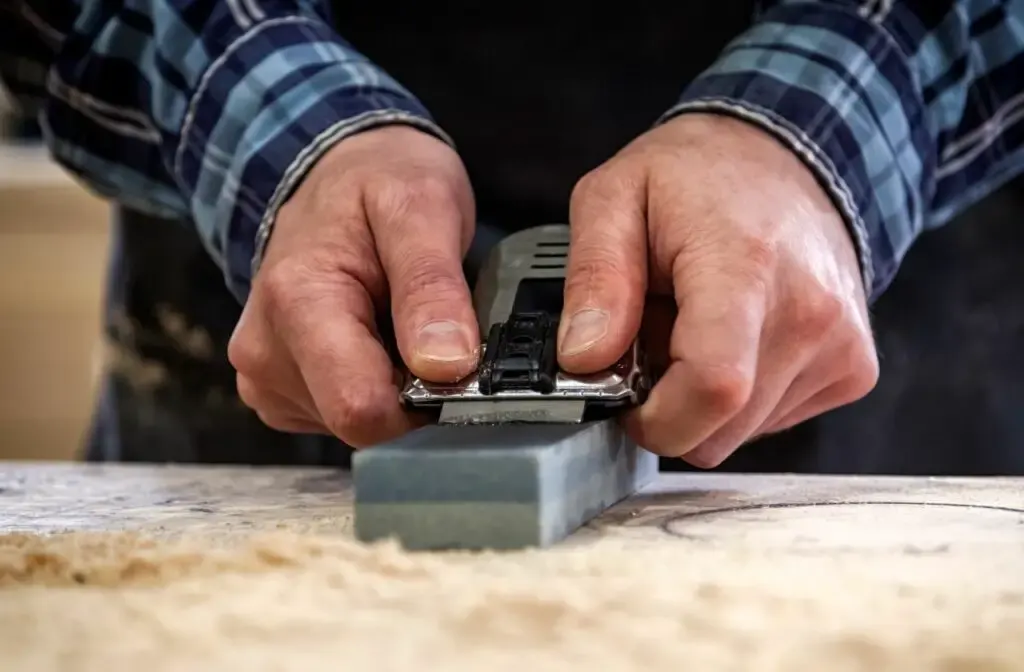
Some whetstone manufacturers produce a lapping stone or a truing stone which is designed specifically for the purpose of flattening whetstones.
The lapping stone comes in various sizes, but it is best to use one that is of a similar size to the whetstone to be flattened. Lapping stones are usually made from silicon carbide abrasive and require water as a lubricant on the stone.
Place the whetstone on a flat non-slip surface, wet the surface of the whetstone, and rub the lapping stone across the surface until flat. Depending on the type of lapping stone, you may need to soak the stone for 5 to 10 minutes in water to keep it lubricated.
A lapping stone may also wear unevenly over time and may require flattening itself from time to time. This flattening process is usually achieved by using a flattening plate with a diamond abrasive.
4. Using A Diamond Plate To Flatten A Whetstone
A diamond plate, a metal plate with a diamond abrasive embedded in the surface, is another method to flatten a whetstone effectively and quickly.
This method is used similarly to a lapping stone. The whetstone to be flattened should be placed on a smooth, flat, non-slip surface. Wet the surface of the whetstone with water and use the diamond plate to grind the sharpening surface flat.
TIP: Diamond sharpening stones are becoming a popular alternative to traditional whetstones. Check out complete guide about diamond stones in the article below:
Diamond Sharpening Stone: Explanation, Cleaning & Storage
Best Way to Flatten Sharpening Stones
The best method for flattening sharpening stones is to use a diamond plate. The diamond abrasive is tough, strong, and the most effective cutting medium on a whetstone.
The diamond plate will not distort or take on the shape of the uneven sharpening stone, and it will not wear as fast as the other options for flattening a stone. The finish on the whetstone will be completely even, smooth, and flat since the metal backing on the diamond plate remains rigid and ensures even wear across the stone.
The only disadvantage to using a diamond plate as a flattening stone is the cost. Diamond plates can be expensive, but you can use the coarse stone to repair damaged knives and flatten other whetstones.
TIP: Using a lubricant with a whetstone is a topic that receives much debate in the knife industry. Use lubricant or not when sharpening your knives on whetstone? Check out the answer in the article below:
Lubricating A Sharpening Stone: The 12 Do’s & Don’ts
How To Keep Sharpening Stone Flat
There are some strategies and tactics you can employ that will help to keep your whetstones flatter for longer and reduce the frequency of flattening your stones.
- Use whetstones on a flat surface. Make sure you have a clean, smooth, flat work surface to sharpen your knives. This will ensure the stone remains secure and flat on your work surface, which will give you a better edge on your knife and prevent uneven wear on the stone.
- Work on your sharpening technique. As your sharpening technique improves, you will become more aware of pressure differentials on different parts of the blade during different parts of the sharpening strokes. As you get the “feel” for this, your technique will improve to give you sharper knives and produce a more even wear pattern on the whetstone surface.
- Flatten your sharpening stones regularly. Brief flattening before each sharpening will keep the stone flatter for longer, reducing the need for a more intensive flattening of the stone. Flattening more regularly will keep your sharpening stones flat and give you a better edge on your knives.
BTW: If you want to know more about Japanese and other knives and their sharpening, check out the books listed above. These books are recommended by professional sharpeners and knife makers (Amazon links):
- Japanese Kitchen Knives: Essential Techniques and Recipes
- The Knifenerd Guide to Japanese Knives
- Knife: The Culture, Craft, and Cult of the Cook’s Knife
- Sharp: The Definitive Introduction to Knives, Sharpening, and Cutting Techniques, with Recipes from Great Chefs
Common Questions and Misconceptions About Sharpening Stones
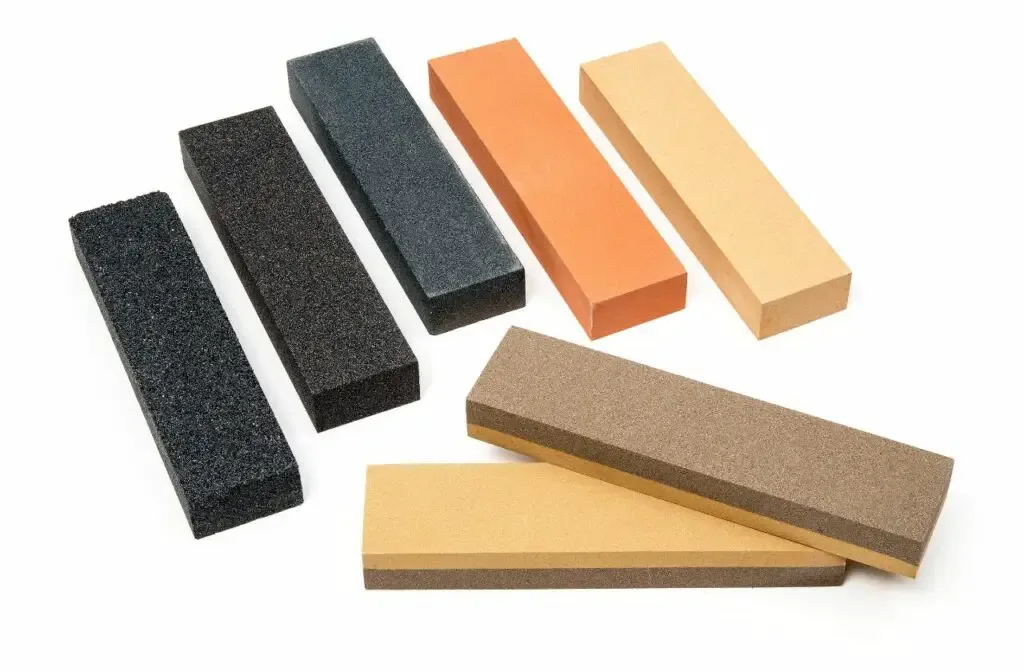
Do all sharpening stones need to be soaked before use?
Misconception: All stones must be soaked in water before sharpening.
Reality: Only water stones require soaking. Oil stones and ceramic stones do not. Check the manufacturer’s instructions for your specific stone type.
Are expensive sharpening stones always better?
Misconception: The more expensive a sharpening stone, the superior its sharpening capabilities.
Reality: Price can be an indicator of quality, but the best stone depends on your specific needs, knife type, and sharpening skill level.
Can I use oil and water interchangeably on my stones?
Misconception: Oil and water can be used on the same stone.
Reality: You should not use oil on a water stone or vice versa. Doing so can damage the stone’s surface and reduce its effectiveness.
Do diamond stones last forever?
Misconception: Diamond stones never wear out.
Reality: While diamond stones are very durable, they can wear out over time, especially if not cleaned properly after use.
Is a finer grit stone always the best choice for sharpening?
Misconception: Finer grit stones are always better for getting a sharp edge.
Reality: The grit you need depends on the condition of your knife. Coarser grits are better for repairing or reprofiling an edge, while finer grits are for refining and polishing.
Can I sharpen serrated knives on a flat whetstone?
Misconception: Flat whetstones can be used to sharpen serrated knives.
Reality: Serrated knives typically require a rod-shaped sharpener to properly hone the serrations.
Does flattening a stone wear it out quickly?
Misconception: Regular flattening wears out the stone quickly.
Reality: Flattening is a maintenance task that extends the life of the stone by ensuring it provides a consistent sharpening surface.
Can I use any stone for any type of knife?
Misconception: All stones are suitable for all types of knives.
Reality: Different stones are better suited for different types of knives and metals. For example, harder stones are typically better for harder steel knives.
Is sharpening with a stone better than using a sharpening machine?
Misconception: Machine sharpeners are better because they are faster and require less skill.
Reality: While sharpening machines are quick and easy, stones offer more control and can produce a superior edge when used properly.
Conclusion
Whetstones undergo wear during the process of knife and tool sharpening. If the wear is uneven, the whetstone sharpening surface can become misshapen. If left unaddressed, the uneven surface will affect the quality of the edge of the knife.
Flattening the stone is the only way to restore the whetstone’s surface so that it will once again be effective for sharpening your knives. Methods to flatten whetstones range from cheap sandpaper to quality, expensive diamond plates.
Whichever sharpening stone flattening method you choose, it is important to flatten your whetstones regularly to ensure a quality edge on your knives after sharpening!
TIP: Whetstones themselves require care and maintenance to keep them performing optimally and extend their longevity. Check out the proven tips for longer endurance of your whetstone in the article below:
14 Care Tips For Better & Longer Endurance Of Your Whetstone
